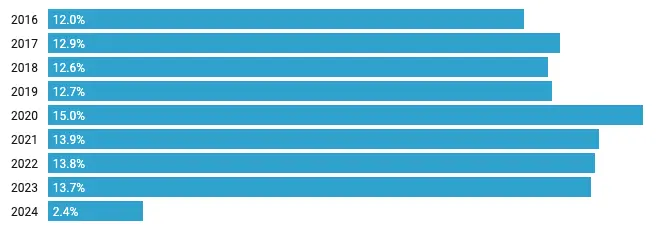As the first quarter of the year wraps up, the auto industry finds itself at a fascinating crossroads. While overall new light-vehicle market sales have revved up by 5.6%, there’s an unexpected twist in the narrative: the giants of the road, our beloved pickup trucks, have seemingly veered off the growth path.
This peculiar scenario begs a deeper exploration into the why and how of this trend, especially in a segment known for its robustness and reliability.
Exploring the Reasons Behind Pickup Trucks’ Q1 Sales Decline (PDF)
Pickup Trucks: The Quarter’s Unexpected Detour
The U.S. auto industry has witnessed its first back-to-back first-quarter sales gains since the Obama administration, heralding a positive rebound. However, amidst this resurgence, the segment of large pickups has shown a downturn, marking a 4% decline from January through March. This dip is particularly striking against the backdrop of the overall new light-vehicle market’s growth.
Full-size pickups’ share of first-quarter U.S. light-vehicle sales

A Closer Look at the Numbers
Let’s delve into the specifics with a table that sheds light on the performance of key players in the pickup segment:
| Brand | Model(s) | Q1 2024 Sales Decline |
|---|---|---|
| Ram | 1500 Pickup | -15% |
| Ford Motor Co. | F-Series Line | -10% |
| General Motors | Light-Duty Full-Size Pickups | -1.2% |
Despite these declines, it’s noteworthy that GM and Nissan were the only automakers to see an uptick in pickup sales compared to Q1 2023. The overall landscape for pickups, however, was less rosy, with total sales dipping by 6.4%, including a significant 31% drop in midsize nameplates.
Unraveling the Mystery: Why Are Pickups Lagging?
The Price and Interest Rate Hurdle
Analysts point towards a growing consumer hesitation around big-ticket purchases like large pickups, driven by rising prices and interest rates. This economic environment seems to have steered buyers towards more economical choices, such as smaller vehicles and compact pickups like the Ford Maverick, which astonishingly surged 82% in sales.
Changing Consumer Preferences
There’s also a shift in consumer behavior, with a preference for functionality over size. This trend suggests a market that’s increasingly looking for the utility that pickups offer but in more affordable and efficient packages.
The Impact of External Factors
Beyond market dynamics, other external factors have played a role. Logistical challenges, including delays in shipments and quality checks, have contributed to inventory backlogs, particularly noted with Ford’s electric F-150 Lightnings and other models.
The Road Ahead for Pickups
Despite the Q1 setback, the segment’s future isn’t bleak. With automakers like GM and Stellantis making strategic moves to refresh their lineups and improve sales strategies, there’s potential for a rebound.
Additionally, the pickup segment’s diversification, with an emphasis on electric models and high-end trims, might eventually draw back the consumer base looking for a blend of luxury, functionality, and sustainability.
As we navigate through the rest of 2024, it will be intriguing to see how pickup trucks adjust their course. With the auto industry’s landscape continually evolving, pickups may need to redefine their value proposition to align with the shifting economic conditions and consumer preferences.
Will they manage to accelerate back into the fast lane of sales growth, or is this the beginning of a more significant shift in the market? Only time will tell, but one thing is clear: the road ahead is filled with opportunities for innovation and adaptation. What do you think lies ahead for the pickup truck segment?



